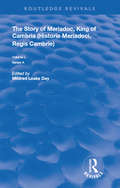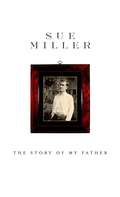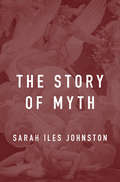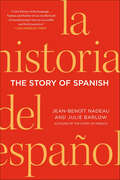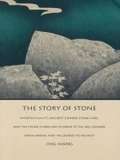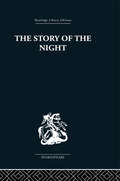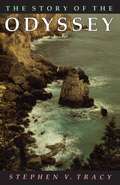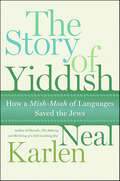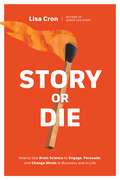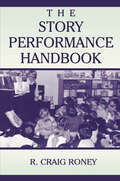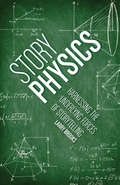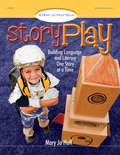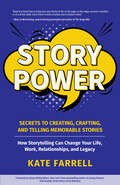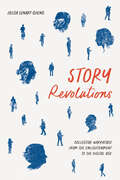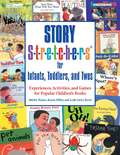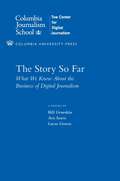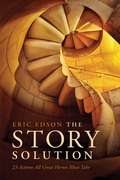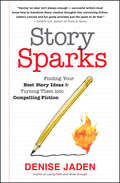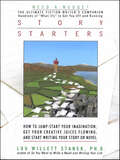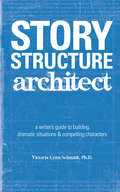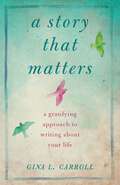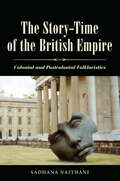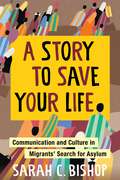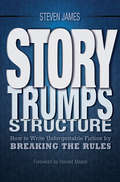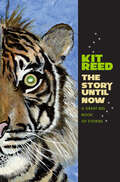- Table View
- List View
The Story of Meriadoc, King of Cambria (Routledge Revivals)
by Mildred Leake DayPublished in 1988: The Story of Meriadoc, King of Cambria is about a prince of the kingdom of Cambria (pre-Saxon Wales) who after surviving an attempted assassination by his uncle, fights as a young Knight in the cause of royal justice.
The Story of My Father: A Memoir
by Sue MillerNovelist Sue Miller writes with stunning truthfulness about her father's slow and irrevocable descent into Alzheimers disease, and her anguished struggle to care for him and maintain emotional contact. She reflects upon her father's life and the dynamics of her family as past patterns are sometimes unraveled, sometimes reinforced. In a moving afterword Miller describes how she came to terms with her father's death and explains how she decided to write this book.
The Story of Myth
by Sarah Iles JohnstonSarah Iles Johnston argues that the nature of myths as gripping tales starring vivid characters enabled them to do their most important work: sustaining belief in the gods and heroes of Greek religion. She shows how Greek myths—and the stories told by all cultures—affect our shared view of the cosmos and the creatures who inhabit it.
The Story of Spanish
by Jean-Benoît Nadeau Julie BarlowThe authors of The Story of French are back with a new linguistic history of the Spanish language and its progress around the globe.Just how did a dialect spoken by a handful of shepherds in Northern Spain become the world's second most spoken language, the official language of twenty-one countries on two continents, and the unofficial second language of the United States? Jean-Benoît Nadeau and Julie Barlow, the husband-and-wife team who chronicled the history of the French language in The Story of French, now look at the roots and spread of modern Spanish. Full of surprises and honed in Nadeau and Barlow's trademark style, combining personal anecdote, reflections, and deep research, The Story of Spanish is the first full biography of a language that shaped the world we know, and the only global language with two names—Spanish and Castilian. The story starts when the ancient Phoenicians set their sights on "The Land of the Rabbits," Spain's original name, which the Romans pronounced as Hispania. The Spanish language would pick up bits of Germanic culture, a lot of Arabic, and even some French on its way to taking modern form just as it was about to colonize a New World. Through characters like Queen Isabella, Christopher Columbus, Cervantes, and Goya, The Story of Spanish shows how Spain's Golden Age, the Mexican Miracle, and the Latin American Boom helped shape the destiny of the language. Other, more somber episodes, also contributed, like the Spanish Inquisition, the expulsion of Spain's Jews, the destruction of native cultures, the political instability in Latin America, and the dictatorship of Franco. The Story of Spanish shows there is much more to Spanish than tacos, flamenco, and bullfighting. It explains how the United States developed its Hispanic personality from the time of the Spanish conquistadors to Latin American immigration and telenovelas. It also makes clear how fundamentally Spanish many American cultural artifacts and customs actually are, including the dollar sign, barbecues, ranching, and cowboy culture. The authors give us a passionate and intriguing chronicle of a vibrant language that thrived through conquests and setbacks to become the tongue of Pedro Almodóvar and Gabriel García Márquez, of tango and ballroom dancing, of millions of Americans and hundreds of millions of people throughout the world.
The Story of Stone: Intertextuality, Ancient Chinese Stone Lore, and the Stone Symbolism in Dream of the Red Chamber, Water Margin, and The Journey to the West
by Jing WangIn this pathbreaking study of three of the most familiar texts in the Chinese tradition--all concerning stones endowed with magical properties--Jing Wang develops a monumental reconstruction of ancient Chinese stone lore. Wang's thorough and systematic comparison of these classic works illuminates the various tellings of the stone story and provides new insight into major topics in traditional Chinese literature.Bringing together Chinese myth, religion, folklore, art, and literature, this book is the first in any language to amass the sources of stone myth and stone lore in Chinese culture. Uniting classical Chinese studies with contemporary Western theoretical concerns, Wang examines these stone narratives by analyzing intertextuality within Chinese traditions. She offers revelatory interpretations to long-standing critical issues, such as the paradoxical character of the monkey in The Journey to the West, the circularity of narrative logic in The Dream of the Red Chamber, and the structural necessity of the stone tablet in Water Margin.By both challenging and incorporating traditional sinological scholarship, Wang's The Story of Stone reveals the ideological ramifications of these three literary works on Chinese cultural history and makes the past relevant to contemporary intellectual discourse. Specialists in Chinese literature and culture, comparative literature, literary theory, and religious studies will find much of interest in this outstanding work, which is sure to become a standard reference on the subject.
The Story of the Night: Studies in Shakespeare's Major Tragedies
by John HollowayFirst published in 1961. Critiquing the critics, and examining the vocabulary of twentieth century criticism of the Shakespearean tragedies, John Holloway's book covers Hamlet, Othello, Macbeth, King Lear, Antony and Cleopatra, Coriolanus, Timon of Athens and the themes of Shakespearean Tragedy and the idea of human sacrifice and the concepts of myth and ritual in literature.
The Story of the Odyssey
by Stephen V. TracyHere Stephen Tracy offers a vivid, fast-paced narrative that serves as a reading guide to Homer's monumental epic. He not only provides translations of key passages and traces the evolution of major themes in the Odyssey, but also helps new readers to understand the artistry of one of the best tales ever told. Aimed at advanced readers as well, this book stresses an appreciation of how Homer has ordered his narrative, covering such topics as character interaction, family relationships, elements of poetic language, and the symbolic treatment of death, rebirth, growth, and knowledge. Given the controversy over the way the Odyssey was composed and handed down, Tracy concentrates on presenting the poem as a highly unified work. His analysis of the narrative structure reveals the epic to be arranged as a series of parallel journeys. The journey, seen here as a symbol of growth and self-knowledge, is among the major themes discussed in detail, along with the importance of women as overseers of life's journeys and the need for the sons of heroes to grow up worthy of their fathers.
The Story of Yiddish: How a Mish-Mosh of Languages Saved the Jews
by Neal KarlenYiddish—an oft-considered "gutter" language—is an unlikely survivor of the ages, much like the Jews themselves. Its survival has been an incredible journey, especially considering how often Jews have tried to kill it themselves. Underlying Neal Karlen's unique, brashly entertaining, yet thoroughly researched telling of the language's story is the notion that Yiddish is a mirror of Jewish history, thought, and practice—for better and worse. Karlen charts the beginning of Yiddish as a minor dialect in medieval Europe that helped peasant Jews live safely apart from the marauders of the First Crusades. Incorporating a large measure of antique German dialects, Yiddish also included little scraps of French, Italian, ancient Hebrew, Aramaic, the Slavic and Romance languages, and a dozen other tongues native to the places where Jews were briefly given shelter. One may speak a dozen languages, all of them Yiddish.By 1939, Yiddish flourished as the lingua franca of 13 million Jews. After the Holocaust, whatever remained of Yiddish, its worldview and vibrant culture, was almost stamped out—by Jews themselves. Yiddish was an old-world embarrassment for Americans anxious to assimilate. In Israel, young, proud Zionists suppressed Yiddish as the symbol of the weak and frightened ghetto-bound Jew—and invented modern Hebrew. Today, a new generation has zealously sought to explore the language and to embrace its soul. This renaissance has spread to millions of non-Jews who now know the subtle difference between a shlemiel and a shlimazel; hundreds of Yiddish words dot the most recent editions of the Oxford English Dictionary.The Story of Yiddish is a delightful tale of a people, their place in the world, and the fascinating language that held them together.
Story or Die: How to Use Brain Science to Engage, Persuade, and Change Minds in Business and in Life
by Lisa Cron&“A practical, heartfelt manual for anyone who needs to change minds and actions. Lisa Cron shares the art of practical empathy with leaders who care enough to make a difference.&”—Seth Godin, author of The Practice A step-by-step guide to using the brain&’s hardwired need for story to achieve any goal, from the author of Wired for Story Whether you&’re pitching a product, saving the planet, or convincing your kids not to text and drive, story isn&’t just one way to persuade. It&’s the way. It&’s built into the architecture of the brain, and has been since early humans gathered around the camp fire, trying to figure out how to outsmart the lion next door.In Story or Die, story coach Lisa Cron sets out to decode the power of story, first by examining how the brain processes information, translates it into narrative, and then guards it as if your life depends on it. Armed with that insight, she focuses on how to find your real target audience and then pinpoint their hidden resistance. Finally, she takes you, step-by-step, through the creation of your own story, one that allows your audience to overcome their resistance and take up your call to action, not because you told them to, but because they want to.That is the power of story. Use it wisely.
The Story Performance Handbook
by R. Craig RoneyThe Story Performance Handbook provides specific, detailed information to help adults develop basic skills in reading aloud, mediated storytelling, and storytelling. Organized sequentially, each chapter moves the reader from the easiest (reading aloud picture books) to the most difficult (creating your own stories for telling) storytelling experience, cumulatively building story performance skill in selecting, preparing, and delivering stories and poetry to audiences. This structure allows individuals to begin reading at various points depending on their prior experience with story performance. The text includes several features that make learning to perform stories and poetry easy to understand and manage: * Explicit, thorough advice avoids confusion, such as how to select, prepare, and deliver stories and poetry via reading aloud, mediated storytelling, and storytelling. * The sequential chapter organization, progressing from easiest to most difficult, and Developmental and Culminating Activities at the end of each skill chapter, enable this text to be used either independently or in conjunction with courses or workshops in story performance. * Unique among story performance texts, instruction is based not only on the author's own extensive experience but also on empirical research related to teaching adults to tell stories. * Specific information is easily located throughout the text: Processes are presented in bold type, numbered sequentially and, at the end of specific chapters, skill building activities are provided. Figures (which provide additional detailed information) are boxed. Examples of processes are highlighted with background shading.
Story Physics: Harnessing the Underlying Forces of Storytelling
by Larry BrooksLearn how to make your story soar! In the physical world, gravity, force, and other elements of physics govern your abilities and can be utilized to enhance your every movement. In the world of writing, story physics can be harnessed in much the same way to make your novel or screenplay the best it can be. In Story Physics, best-selling author Larry Brooks introduces you to six key literary forces that, when leveraged in just the right way, enable you to craft a story that's primed for success--and publication. Inside Story Physics, you'll learn how to: Understand and harness the six storytelling forces that are constantly at work in your fiction. Transform your story idea into a dramatically compelling concept. Optimize the choices you make in terms of character, conflict, subplot, subtext, and more to render the best possible outcome. These literary forces will elevate your story above the competition and help you avoid the rejection pile. With Story Physics, you won't just give your story wings--you'll teach it how to fly. "Larry Brooks speaks my kind of language about story. Any writer, even those trucking in the world of nonfiction, will benefit from going deeper into the physics of storytelling as Brooks explains in these pages." - James Scott Bell, best-selling author of Plot & Structure "Larry Brooks has done it again! If you liked Story Engineering, I suspect you're going to love Story Physics, which dives even deeper into the essence of story. Story Physics is an essential addition to every novelist's bookshelf." - Randy Ingermanson, author of Writing Fiction for Dummies
Story Play: Building Language and Literacy One Story at a Time
by Mary Jo HuffWhen a story comes to "The End" it does not have to be the end of the story. Instead, teachers can continue the learning with activities and experiences to promote conversation about that story. Story Play encourages even the most inexperienced teacher, librarian, child care professional, or family member to become a storyteller with ideas for expanding stories into meaningful learning experiences. With stories, poems, songs, chants, and fingerplays, as well as ideas for working with puppets and props, Story Play brings all the fun of storytelling into the classroom in new ways. These easy-to-follow ideas focus on literacy skills and are perfect for engaged, active learning.
Story Power: Secrets to Creating, Crafting, and Telling Memorable Stories
by Kate FarrellA straightforward guide to creating a great story that keeps your audience riveted.The art of telling stories has been around as long as humans. And in today’s noisy, techy, automated world, storytelling is not only prevalent?it’s vital. Whether you're interested in enlivening verbal communication, building your business brand, making presentations, sharing family wisdom, or performing on stage, Story Power shows you how to make use of a good story.Telling stories is the most effective verbal communication?if you know how to use it. Story Power provides techniques for creating and framing personal stories alongside effective tips for telling them in any setting. Plus, this book models stories with unique storytelling examples, exercises, and prompts, as well as storytelling techniques for delivery in a spontaneous, authentic style.Story Power is an engaging, lively guide to the art of telling stories from author and librarian Kate Farrell, a seasoned storyteller and founder of the Word Weaving Storytelling Project. In Story Power, more than twenty skillful contributors with a range of diverse voices share their secrets to creating, crafting, and telling tales.In this book discover:How to share your own coming-of-age stories and family folkloreThe importance of a personal branding story and storytelling marketingSeven Steps to Storytelling, along with helpful tools, organizers, and media optionsWith a foreword by New York Times bestselling, award-winning author Susan Wittig AlbertPraise for Story Power“You can read a lot of books that tell you how to tell a story. Unlike them, Story Power illustrates the art, with twenty-one diverse voices and fascinating tales that entertain as you learn how to create and craft personal stories of all types.” —Nina Amir, bestselling author of How to Blog a Book, The Author Training Manual, and Creative Visualization for Writers“Mining her own experiences, Farrell offers small narrative gems alongside craft tips, commentary, and writing samples from an impressive list of acclaimed writers. Learn travel writing from Lisa Alpine, for example, or keys to crafting adventure stories from Mary Mackey, or personal branding from Marissa Moss . . . . Engaging and accessible, Story Power will help you jump-start and sustain your writing practice.” —Mary Volmer, author of Reliance, Illinois
Story Revolutions: Collective Narratives from the Enlightenment to the Digital Age (Cultural Frames, Framing Culture)
by Helga Lenart-ChengSocial media has facilitated the sharing of once isolated testimonies to an extent and with an ease never before possible. The #MeToo movement provides a prime example of how such pooling of individual stories, in large enough numbers, can fuel political movements, fortify a sense of solidarity and community, and compel public reckoning by bringing important issues into mainstream consciousness.In this timely and important study, Helga Lenart-Cheng has uncovered the antecedents of this phenomenon and provided a historical and critical analysis of this seemingly new but in fact deeply rooted tradition. Story Revolutions features a rich variety of case studies, from eighteenth-century memoir collections to contemporary Web 2.0 databases, including memoir contests, digital story-maps, crowd-sourced Covid diaries, and AI-assisted life writing. It spans the Enlightenment, the 1930s, and the twenty-first century—three historical periods marked by a convergence of mass movements and new methods of data collection that led to a boom in activism based in the aggregation and communication of stories. Ultimately, this book offers readers a critical perspective on the concept of community itself, with incisive reflections on what it means to use storytelling to build democracy in the twenty-first century.
Story S-t-r-e-t-c-h-e-r-s for the Primary Grades, Revised: Activities to Expand Children's Books, Revised Edition
by Shirley Raines Brian Scott SmithThere is nothing that children love more than a good story. Story S-t-r-e-t-c-h-e-r-s for the Primary Grades, Revised connects 90 of the best children's books to early learning centers, stretching each story five ways with lively and entertaining activities that heighten reading readiness, sharpen comprehension skills, and expand the excitement of story time. Pulling the best stories from the original books, this new edition also features new children's books as well as old favorites, refreshed activities, and online references for expanding story experiences.
The Story So Far: What We Know About the Business of Digital Journalism (Columbia Journalism Review Books)
by Bill Grueskin Ava Seave Lucas GravesBill Grueskin, Ava Seave, and Lucas Graves spent close to a year tracking the reporting of on-site news organizations-some of which were founded over a century ago and others established only in the past year or two-and found in their traffic and audience engagement patterns, allocation of resources, and revenue streams ways to increase the profits of digital journalism. In chapters covering a range of concerns, from advertising models and alternative platforms to the success of paywalls, the benefits and drawbacks to aggregation, and the character of emerging news platforms, this volume identifies which digital media strategies make money, which do not, and which new approaches look promising. The most comprehensive analysis to date of digital journalism's financial outlook, this text confronts business challenges both old and new, large and small, suggesting news organizations embrace the unique opportunities of the internet rather than adapt web offerings to legacy business models. The authors ultimately argue that news organizations and their audiences must learn to accept digital platforms and their constant transformation, which demand faster and more consistent innovation and investment.
The Story Solution: 23 Actions All Great Heroes Must Take
by Eric EdsonEric Edson has developed a new tool for bringing depth and passion to any screenplay - the ""23 Steps All Great Heroes Must Take."" It's an easy to understand paradigm that provides writers and filmmakers the interconnecting, powerful storytelling elements they need. With true insight, a master teacher of screenwriting pinpoints the story structure reasons most new spec scripts don't sell; then uses scores of examples from popular hit movies to present, step by step, his revolutionary Hero Goal Sequences blueprint for writing blockbuster movies.
Story Sparks: Finding Your Best Story Ideas and Turning Them into Compelling Fiction
by Denise JadenFind rock-solid story ideas before you start writingAnyone who has been hamster-wheeling a story idea for years or has hundreds of pages exploring various approaches on their hard drive knows that there must be a better way. There is. Young adult novelist Denise Jaden shows exactly how to create the captivating stories that prevent dispiriting wasted time. Busting the "visitation from the muses" myth, she shows that inspiration is a skill writers can learn by understanding how story ideas work (or don't), fertilizing the ground for fresh and sound ideas, and moving swiftly through stuck points. Practical and inspiring, Jaden's approach celebrates the imaginative sparks that make innovations of all kinds possible while pinpointing the precise tools writers need to fan their unique creative flames.
Story Starters: How to Jump-Start Your Imagination, Get Your Creative Juices Flowing, and Start Writing Your Story or Novel
by Lou Willett StanekIf you have the passion and energy to write fiction, but have trouble finding an idea and getting started, this is the perfect book for you. Lou Willett Stanek has helped scores of new authors in her acclaimed writing workshops—and now she shows you how to look and listen, how to find stories and begin shaping them like a writer.Here's how to find inspiration from neighbors and strangers, reshape classic tales, cull current events and use other tricks of the writing trade so effectively you'll soon find yourself brimming with ideas, your imagination revved to its full potential. Begin with a snippet of overheard conversation, an unexpected event, a simple character trait, a place, a problem—Ms. Stanek teaches you to get past "what really happened" and reinvent reality in ways that will astound and delight you, and hold a reader's attention.Here too are hundreds of "what-ifs," simple situations you can guide to endlessly different conclusions—and use to learn new ways to fashion plot, describe character, develop conflict, paint with language, create a setting, employ flashbacks, build suspense, and much, much more. For every writer who could use a jump-start, from novice to pro, here is a book that will help you keep the faith and. . .Thousands of stories are just waiting to be told—by you. Get started!
Story Structure Architect: A Writer's Guide to Building Dramatic Situations and Compelling Characters
by Victoria Lynn SchmidtBuild a Timeless, Original Story Using Hundreds of Classic Story Motifs! It's been said that there are no new ideas; but there are proven ideas that have worked again and again for all writers for hundreds of years. Story Structure Architectis your comprehensive reference to the classic recurring story structures used by every great author throughout the ages. You'll find master models for characters, plots, and complication motifs, along with guidelines for combining them to create unique short stories, novels, scripts, or plays. You'll also learn how to: Build compelling stories that don't get bogged down in the middle Select character journeys and create conflicts Devise subplots and plan dramatic situations Develop the supporting characters you need to make your story work Especially featured are the standard dramatic situations inspire by Georges Polti's well-known 19th century work,The Thirty-Six Dramatic Situations. But author Victoria Schmidt puts a 21st-century spin on these timeless classics and offers fifty-five situations to inspire your creativity and allow you even more writing freedom. Story Structure Architectwill give you the mold and then help you break it. This browsable and interactive book offers everything you need to craft a complete, original, and satisfying story sure to keep readers hooked!
A Story That Matters: A Gratifying Approach to Writing About Your Life
by Gina L. CarrollNo matter who you are, your story is a part of something big—the fabric of history and the human experience. Once written and shared, your story will change someone. And that someone is most likely you. A Story that Matters offers an accessible and simplified way to get your stories written. Each chapter is divided into three sections: the first discusses memoir writing in the context of themes—motherhood, childhood, relationships, professional life, and spiritual journey; the second provides basic writing and editing prescription, with a focus on common beginner mistakes and roadblocks; and the third provides a sample story related to the life theme discussed in the first section of the chapter. Chock full of writing and editing lessons that focus on how to get a first draft written and how to craft the draft into a compelling story, A Story That Matters explores our ability to help, heal, and connect to others through story, reminding us of the greater need for a broader array of authentic voices in the story-sharing universe.
The Story-Time of the British Empire: Colonial and Postcolonial Folkloristics
by Sadhana NaithaniIn The Story-Time of the British Empire, author Sadhana Naithani examines folklore collections compiled by British colonial administrators, military men, missionaries, and women in the British colonies of Africa, Asia, and Australia between 1860 and 1950. Much of this work was accomplished in the context of colonial relations and done by non-folklorists, yet these oral narratives and poetic expressions of non-Europeans were transcribed, translated, published, and discussed internationally. Naithani analyzes the role of folklore scholarship in the construction of colonial cultural politics as well as in the conception of international folklore studies. Since most folklore scholarship and cultural history focuses exclusively on specific nations, there is little study of cross-cultural phenomena about empire and/or postcoloniality. Naithani argues that connecting cultural histories, especially in relation to previously colonized countries, is essential to understanding those countries' folklore, as these folk traditions result from both internal and European influence. The author also makes clear the role folklore and its study played in shaping intercultural perceptions that continue to exist in the academic and popular realms today. The Story-Time of the British Empire is a bold argument for a twenty-first-century vision of folklore studies that is international in scope and that understands folklore as a transnational entity.
A Story to Save Your Life: Communication and Culture in Migrants' Search for Asylum
by Sarah BishopA young woman flees violence in Mexico and seeks protection in the United States—only to be trafficked as a domestic worker in the Bronx. A decorated immigration judge leaves his post when the policies he proudly upheld capsize in the wake of political turmoil. A Gambian translator who was granted asylum herself talks with other African women about how immigration officers expect victims of torture to behave. A border patrol officer begins to question the training that instructs him to treat the children he finds in the Arizona desert like criminals.Through these and other powerful firsthand accounts, A Story to Save Your Life offers new insight into the harrowing realities of seeking protection in the United States. Sarah C. Bishop argues that cultural differences in communication shape every stage of the asylum process, playing a major but unexamined role. Migrants fleeing persecution must reconstruct the details of their lives so governmental authorities can determine whether their experiences justify protection. However, Bishop shows, many factors influence whether an applicant is perceived as credible, from the effects of trauma on the ability to recount an experience chronologically to culturally rooted nonverbal behaviors and displays of emotion. For asylum seekers, harnessing the power of autobiographical storytelling can mean the difference between life and death. A Story to Save Your Life emphasizes how memory, communication, and culture intertwine in migrants’ search for safety.
Story Trumps Structure: How to Write Unforgettable Fiction by Breaking the Rules
by Steven JamesDon't limit your fiction - LIBERATE ITAll too often, following the "rules" of writing can constrict rather than inspire you. With Story Trumps Structure, you can shed those rules - about three-act structure, rising action, outlining, and more - to craft your most powerful, emotional, and gripping stories.Award-winning novelist Steven James explains how to trust the narrative process to make your story believable, compelling, and engaging, and debunks the common myths that hold writers back from creating their best work.Ditch your outline and learn to write organically.Set up promises for readers - and deliver on them.Discover how to craft a satisfying climax.Master the subtleties of characterization.Add mind-blowing twists to your fiction.When you focus on what lies at the heart of story - tension, desire, crisis, escalation, struggle, discovery - rather than plot templates and formulas, you'll begin to break out of the box and write fiction that resonates with your readers. Story Trumps Structure will transform the way you think about stories and the way you write them, forever.
The Story Until Now: A Great Big Book of Stories
by Kit ReedThe best stories from a master of speculative fiction Called "one of our brightest cultural commentators" by Publishers Weekly, Kit Reed draws from life—with a difference. This new collection brings together thirty-four of her strong, original stories, from early classics like "The Wait" and "Winter" to six never-before-collected short stories, including "The Legend of Troop 13" and "Wherein We Enter the Museum." An early favorite, "Automatic Tiger," is the first in a series of Reed's stories about animals. There's a monkey who grinds out bestsellers with the help of a "creative writing" app. Her uncanny black dog can enter a crowded room and sit down at the feet of the next man to die. Her characters confront war in various arenas: mother/daughter battles, the war of the sexes, the struggles of men scarred by war. Kit Reed's self-described "transgenred" fiction is confirmation of an "extraordinary talent" (The Financial Times). The range and complexity of her work speaks for itself in The Story Until Now.
